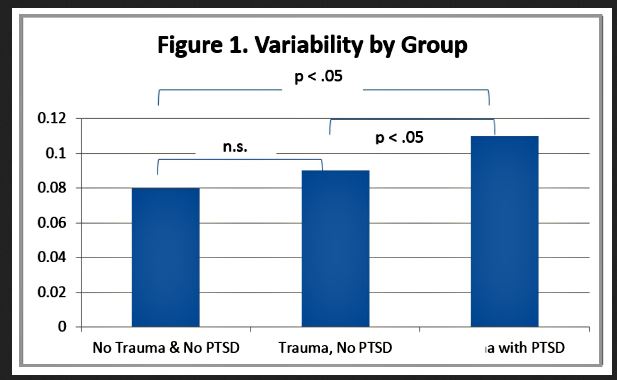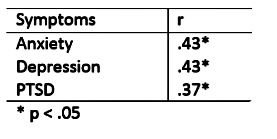Teaching with the Journal of Traumatic Stress (JOTS) II
Kathryn Becker-Blease, PhD
January 2, 2015
In the first Teaching Trauma with JOTS column, I introduced the idea of using articles from the Journal of Traumatic Stress (JOTS) to teach both trauma and scientific literacy using MCAT-style multiple choice tests. Multiple-choice tests, when carefully constructed, are an easy way for instructors to not just assess knowledge, but also teach, even in large lecture courses.
In this column, I present a second MCAT-style question along with some resources for teaching about a recent Journal of Traumatic Stress publication. This question may be rather technical for some classes, but is a great way of showing students in appropriate classes the breadth of research methods that researchers use to study trauma.
Resources
Dot Probe Task: Static diagrams explaining the sequence of dot probe screen shots are available in a basic web search for “dot probe task”. To be consistent with the methodology in this study, choose one with threat-related words (not images).
A web-based demonstration of a dot-probe task is available at http://www.millisecond.com/download/library/v4/DotProbe/DotProbe.web. It requires a software download that was quick and easy on my desktop, but would need to be set up before presenting in a classroom.
Note: The MCAT-style question below is based on the following article:
Iacoviello, B. M., Wu, G., Abend, R., Murrough, J. W., Feder, A., Fruchter, E., Levinstein, Y., Wald, I., Bailey, C., Pine, D., Neumeister, A., Bar-Haim, Y. & Charney, D. S. (2014). Attention bias variability and symptoms of posttraumatic stress disorder. Journal of Traumatic Stress, 27(2), 232-239. doi: 10.1002/jts.21899
Attentional Control and PTSD
Following a traumatic event, most people do not develop Post-traumatic Stress Disorder (PTSD), but some do. PTSD causes people to both experience an increased awareness of reminders of the traumatic event and to avoid reminders of the traumatic event. When people tend to pay attention automatically to a certain information, researchers say they show an attentional bias. An attentional bias toward threat-related information may be related to hypervigilance symptoms in PTSD. On the other hand, an attention bias away from threat-related information may be related to avoidance symptoms in PTSD. Researchers have tested this using the dot-probe task.
In the dot-probe task, participants are shown neutral (e.g. dishwasher) and threat-related (e.g. death) words that appear at the top or bottom of a computer screen. They are told to focus at the center of the screen while the words appear. In between the words, a symbol appears at the top or bottom of the screen. Researchers measure how quickly participants identify the symbol. If participants do not have any attentional bias, they are equally fast whether the symbol appears in the same location as a neutral or a threat-related world just appeared. If they have a bias toward threat-related words, they will respond faster when the symbol appears in the same location as a threat-related word just appeared. If they have an attentional bias to avoid threat-related words, they will be faster when the symbol appears in the same location as a neutral word just appeared.
The results of several studies have been inconclusive; some studies show that people with PTSD have an attentional bias toward threat-related words and others show an attentional bias away from threat-related words. In the results presented below, the researchers asked a different question. Instead of focusing on speed or attentional bias overall, they looked how variable, or inconsistent, participants’ scores were during the task. They reasoned that a lack of attention control, operationally defined as variability in scores, may be associated with more PTSD symptoms.
The results, shown in Figure 1 (click to enlarge) and Table 1, were consistent with their prediction. Attentional control may be an important factor in the development of PTSD, and it may also account for the inconsistent findings in previous studies.

Table 1. Reaction Time Variability is Positively Related to Mental Health Symptoms

Question Set
The main finding in this study is that post-traumatic stress symptoms are associated with:
-
faster processing of threatening information.
-
anxiety and depression symptoms.
-
less consistency in the speed of processing threatening information.
-
a bias toward paying attention to threatening information.
What evidence presented here supports the conclusion that attentional control is associated specifically with PTSD and not just having experienced a traumatic event?
-
Variability scores for the traumatized group are statistically significantly higher than for the non-traumatized, non-PTSD group.
-
Variability scores for the traumatized group are statistically significantly lower than for the non-traumatized, non-PTSD group.
-
Variability scores for the PTSD group are statistically significantly lower than for the traumatized without PTSD group.
-
Variability scores for the PTSD group are statistically significantly higher than for the traumatized without PTSD group.
These findings show the more depressed someone is
-
the more variable their reaction times.
-
the less variable their reaction times.
-
the faster their reaction times.
-
the slower their reaction times
The average variability score for the group diagnosed with PTSD is:
- .09
- .11
- .37
- .43
Note: Students often have difficulty locating the right source – i.e. figure, table, or passage? –to answer a question. Others identify the correct source, but fail to interpret the information presented there correctly. This question allows you to diagnose both problems.
It is possible that teaching people who had been exposed to trauma to increase their attentional control would make them less likely to develop PTSD in the future. If a researcher were to test this by giving an attentional control intervention to a randomly selected sample of car accident survivors and giving a placebo to others, the researcher would be:
- conducting an experiment (Note: or randomized control trial, depending on the terminology in your course).
- manipulating the dependent variable.
- conducting a case study.
- unable to rule out the possibility that people with poorer attentional control get more PTSD because they are more likely to get into car accidents.
As Traumatic StressPoints is freely available on the web, I have omitted correct answers here.
About the Author
Kathryn Becker-Blease, PhD, is assistant professor in the School of Psychological Science at Oregon State University. Her research interests include developmental traumatology and the science of teaching and learning. One current project focuses on teaching graph reading and research design skills in large Introductory Psychology classes using MCAT-style questions.